Phoenix canariensis
Phoenix canariensis is a species of flowering plant in the palm family Arecaceae, native to the Canary Islands. It is a relative of Phoenix dactylifera, the true date palm. It is the natural symbol of the Canary Islands, together with the canary Serinus canaria.[2] Mature P. canariensis are often used in ornamental landscaping and are collected and transplanted to their new planting location. A Canary Island date palm with 10 m (30 ft) of trunk is approximately 60 years of age.
| Phoenix canariensis | |
|---|---|
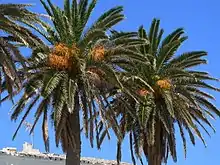 | |
| Scientific classification | |
| Kingdom: | Plantae |
| Clade: | Tracheophytes |
| Clade: | Angiosperms |
| Clade: | Monocots |
| Clade: | Commelinids |
| Order: | Arecales |
| Family: | Arecaceae |
| Genus: | Phoenix |
| Species: | P. canariensis |
| Binomial name | |
| Phoenix canariensis Chabaud | |
Description
Phoenix canariensis is a large solitary palm, 10–20 m (33–66 ft) tall, occasionally growing to 40 m (131 ft). The leaves are pinnate, 4–6 m (13–20 ft) long, with 80–100 leaflets on each side of the central rachis. The fruit is an oval, yellow to orange drupe 2 cm (0.79 in) long and 1 cm (0.39 in) in diameter and containing a single large seed; the fruit pulp is edible but not the best of dates.[3]
Names
Common names in English include Canary Island date palm and pineapple palm. The common name in Spanish-speaking countries and in the Canary Islands is palmera canaria.
Cultivation
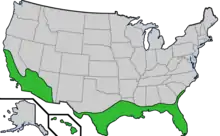
The Canary Island date palm is typically cultivated in wet-winter or Mediterranean climates, but also in wet-summer or humid subtropical climates like eastern Australia and the southeastern United States. There are even several instances of cultivated Canary Island Date Palms in high-latitude oceanic climates, such as Ireland, the UK, and the Channel Islands.[4] It can be cultivated where temperatures rarely fall below −10 or −12 °C (14 or 10 °F) for extended periods, although it will require some protection if cold periods are longer than normal. It is a slowly growing tree, exclusively propagated by seed.
The palm is easily recognized through its crown of leaves and trunk characteristics. It is not uncommon to see Canary Island date palms pruned and trimmed to enhance the appearance.[5] When pruned, the bottom of the crown, also called the nut, appears to have a pineapple shape.
The Canary Island date palm is susceptible to Fusarium wilt, a fungal disease commonly transmitted through contaminated seed, soil, and pruning tools. Spread of the disease can be reduced when pruning tools are disinfected before use on this palm.[6] The South American palm weevil causes them to droop, turn brown and die.
It has gained the Royal Horticultural Society's Award of Garden Merit.[7][8]
Other uses
In the Canary Islands, the sap of this date palm is used to make palm syrup. La Gomera is where most of the sap is produced in the Canary Islands.
Invasiveness
In some areas, Phoenix canariensis has proven to be an invasive plant. In Bermuda and the United States (Florida and California) it is considered naturalised (lives wild in a region where it is not indigenous). It has also spread in some areas of peninsular Spain, Portugal, Italy, Australia, and New Zealand. [9][10][11] It is listed as invasive (naturalized) in coastal southerne California.[12] In Auckland, New Zealand, the palm has itself become a host for the naturalised Australian strangler fig, Ficus macrophylla.
Gallery
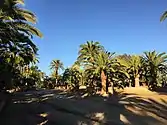 Phoenix canariensis (Canary Island date palm) collection at South Coast Wholesale Nursery San Diego, California
Phoenix canariensis (Canary Island date palm) collection at South Coast Wholesale Nursery San Diego, California Mature Canary island Date in Melborne Florida.
Mature Canary island Date in Melborne Florida. P. canariensis fruit in Northern Florida.
P. canariensis fruit in Northern Florida. Tall, Old Canary Island Palm in Phoenix Arizona.
Tall, Old Canary Island Palm in Phoenix Arizona.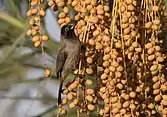 Close-up of fruit
Close-up of fruit Canary Island Date palm growing in Hatteras North Carolina, about their northern limit unprotected on the east coast, many have died further south in cold snaps.
Canary Island Date palm growing in Hatteras North Carolina, about their northern limit unprotected on the east coast, many have died further south in cold snaps. Close-up of flowers
Close-up of flowers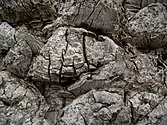 Bark
Bark
References
- Beech, E. (2017). "Phoenix canariensis". IUCN Red List of Threatened Species. 2017: e.T13416997A13417001. doi:10.2305/IUCN.UK.2017-3.RLTS.T13416997A13417001.en.
- "BOC - 1991/061. Viernes 10 de Mayo de 1991 - 577". Gobcan.es. Archived from the original on 8 August 2011. Retrieved 19 January 2018.
- Little, Elbert L. (1994) [1980]. The Audubon Society Field Guide to North American Trees: Western Region (Chanticleer Press ed.). Knopf. p. 324. ISBN 0394507614.
- "Palms in the Channel Islands – by Michael A.F. Carter". The European palm Society. Retrieved 12 December 2013.
- "Canary Island Date Palm - Phoenix canariensis - A-E - Palm Blog". realpalmtrees.com. Retrieved 19 January 2018.
- Elliott, Monica. "Fusarium Wilt of Canary Island Date Palm". UF/IFAS Extension Service. Retrieved 2016-11-21.
- "RHS Plant Selector - Phoenix canariensis". Apps.rhs.org.uk. Retrieved 25 May 2013.
- "AGM Plants - Ornamental" (PDF). Royal Horticultural Society. July 2017. p. 77. Retrieved 25 April 2018.
- "World Checklist of Selected Plant Families: Royal Botanic Gardens, Kew". Apps.kew.org. Retrieved 19 January 2018.
- "Bonap" (PNG). Bonap.net. 2004. Retrieved 19 January 2018.
- "Phoenix canariensis - Species Page - APA: Alabama Plant Atlas". Floraofalabama.org. Retrieved 19 January 2018.
- "Archived copy". Archived from the original on 2016-05-26. Retrieved 2016-06-27.CS1 maint: archived copy as title (link)
External links
| Wikimedia Commons has media related to Canary Island Date Palm. |
- "Phoenix canariensis in the wild". Principes (Journal of the International Palm Society). 42 (2). April 1998. Retrieved 18 May 2008.
